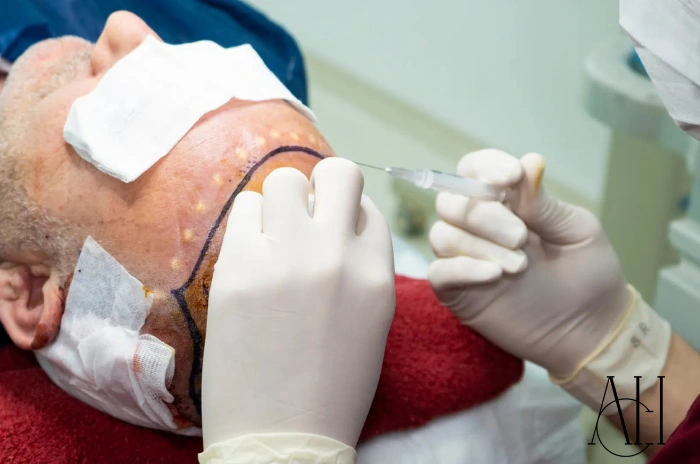Hair loss can significantly impact self-esteem and confidence. Follicular Unit Extraction (FUE) hair transplant has emerged as a popular solution for restoring hair. Albania, with its advanced clinics and affordable prices, has become a sought-after destination for this procedure. This guide provides an in-depth look at FUE hair transplants in Albania, covering everything from the procedure itself to recovery and costs.
Summarize with AI
A hair transplant is a surgical procedure that involves moving hair follicles from one part of the body (usually the back or sides of the scalp) to areas experiencing hair loss. The goal is to restore hair growth in balding or thinning areas, providing a more youthful appearance.
There are primarily two types of hair transplant techniques:
FUE is less invasive than FUT and leaves minimal scarring, making it a preferred choice for many patients.
FUE is a minimally invasive hair transplant technique where individual hair follicles are extracted from the donor area and implanted into the balding or thinning areas. This method avoids the linear scar associated with FUT and offers a quicker recovery time.
The FUE procedure involves the following steps:
Ideal candidates for FUE hair transplant include:
A consultation with a qualified hair transplant surgeon in Albania can determine your suitability for the procedure.
A typical FUE treatment in Albania involves:
Hair growth after FUE follows this timeline:
Recovery from FUE is relatively quick:
FUE is suitable for both men and women experiencing hair loss. Albanian clinic offer personalized treatment plans to address the unique needs of each patient, ensuring optimal results regardless of gender.
Individuals who may not be suitable for FUE include:
A thorough evaluation by a hair transplant specialist is essential to

FUE hair transplantation has evolved into several sub-techniques, each offering unique benefits depending on patient needs and expectations.
It depends on:
Sapphire FUE is increasingly popular in Albanian clinics due to its precision and fast recovery time.
The implantation phase is just as important as extraction.
In Albania, both methods are offered — your surgeon will decide based on density goals and your hair characteristics.
Hair graft quantity depends on the extent of your hair loss.
| Area | Hair Loss Stage | Approx. Grafts Needed |
|---|---|---|
| Hairline only | Norwood 1–2 | 800–1,200 |
| Crown & Hairline | Norwood 3–4 | 1,500–2,500 |
| Full top coverage | Norwood 5–6 | 3,000–4,000+ |
Your surgeon will calculate graft needs during your consultation using density maps and digital scalp analysis.
FUE is a process that focuses on individual follicle movement, minimizing visible scarring.
This delicate process ensures a natural-looking hairline with optimal graft survival.
Understanding the full-day experience can ease anxiety and set expectations.
The entire session typically takes 6–8 hours.
Hair growth is a gradual process.
Full regrowth takes up to 12–15 months, and results vary by individual.
Neograft is a semi-automated FUE device designed to make the process faster and more consistent.
It’s available in select Albanian clinics and appeals to patients seeking uniform results with less variability.
Neograft stands out due to automation.
| Feature | Neograft | Manual FUE |
|---|---|---|
| Speed | Faster | Slower |
| Consistency | High | Surgeon dependent |
| Cost | Slightly higher | Lower |
| Scarring | Minimal | Minimal |

You may be a good fit if:
Neograft is suitable for both men and women, and pricing in Albania is often 40–60% lower than in Western Europe.
Results are similar to manual FUE — if not better.
Many Albanian clinics provide monthly photo tracking to monitor growth progression.
While safe, FUE is still a surgical procedure and carries some risks.
Serious complications are rare and can be avoided by choosing accredited clinics with experienced surgeons.
Hair transplant cost is one of the biggest reasons people travel to Albania.
| Grafts | Price (€) | Includes |
|---|---|---|
| 1,500–2,000 | €1,400–€1,800 | Surgery, hotel, transfers |
| 2,500–3,000 | €1,800–€2,200 | VIP package |
| 3,000–4,000 | €2,200–€2,600 | Premium package with aftercare |
Compared to Germany (€5,000+) or UK (€6,000+), Tirana offers world-class treatment at 60–70% lower prices.
Yes, Albania is considered a safe destination for FUE hair transplants. The country has experienced surgeons and modern clinics that adhere to international standards. Many clinics are accredited by the Albanian Health Ministry, ensuring quality care.
The cost of an FUE hair transplant in Tirana typically ranges from €1,500 to €4,000. Prices vary based on the number of grafts, the clinic’s reputation, and the specific techniques used.
Recovery after an FUE hair transplant usually involves:
Initial healing within 10-14 days.
New hair growth starting around 3 months.
Significant results visible between 6 to 9 months.
Full results achieved by 12 months.
While FUE is minimally invasive, potential risks include:
Swelling and redness.
Temporary numbness or itching.
Shock loss (temporary hair shedding).
Infection (rare with proper aftercare).
Sapphire FUE utilizes sapphire blades to create incisions, allowing for more precise graft placement, reduced tissue trauma, and faster healing compared to traditional steel blades.
Absolutely. FUE hair transplants are suitable for both men and women experiencing hair loss. Clinics in Albania tailor treatments to individual needs, ensuring optimal results for all patients.
WhatsApp us